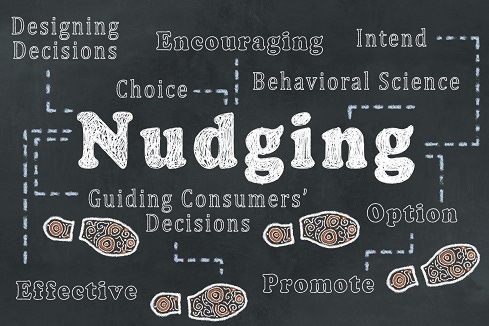Many things in our modern world involve behavior modification. In fact, some organizations are setting up "nudge units," but why?

Messages influencing human behavior are everywhere, but whether they qualify as a "nudge" depends on the definition to which an individual or organization subscribes.
According to the Merriam-Webster online dictionary, "nudge" means (in this context, which is the secondary definition) "to prod lightly or urge into action." The modern view -- where technology and data do the prodding -- is based on the book, Nudge: Improving Decisions About Health, Wealth, and Happiness, which was written by University of Chicago economist Richard Thaler and Harvard Law School Professor Cass Sunstein. While the book sounds like a B2C play, its concepts are playing out in other contexts, including government and enterprises.
According to Jim Guszcza, U.S. chief data scientist at professional services company Deloitte, "nudge" has become a sensation in the public policy realm. However, he underscored the need for organizations to approach nudging scientifically and ethically.
"You want to take a scientific experimental attitude. You don't just say, 'I read something and now I want to try this.' You also need to test and learn," said Guszcza. "From a scientific point of view, you want to design and hypothesize interventions using research and our best understanding of psychology. You test, quantify the benefits, and if it didn't work as well as you’d hoped, find ways to modify it."
Nudging in action
Deloitte helped the State of New Mexico reduce improper unemployment insurance claims by 50% using a combination of data science and nudges. Guszcza helped develop a suspicion score to help identify individuals attempting to collect unemployment benefits improperly. Since algorithmic scoring is probabilistic, it can produce false positives (erroneously assign a high suspicion score to some individuals who are accurately reporting their income).
Rather than investigating all individuals with high suspicion scores or threatening to do so, New Mexico decided to use nudges after a suspicious pattern of behavior had been detected. The nudge was simply an informational message stating the percentage of people in the insurance claimant's zip code who reported their income correctly. Those who were reporting their earnings honestly could simply ignore the message.

James Guszcza
"[We used] a bit of choice architecture called 'social comparisons,' and as the literature suggests, it works," said Guszcza. "We field tested it using randomized controlled trials (A/B testing) and what we found were these messages that were personalized in time using machine learning cut improper payments by half."
"Choice architecture" is a term used by Nudge co-authors Thaler and Sunstein and relates to how choices are presented. Google applied the concept in a number of ways to encourage employees to eat healthier. However, getting a choice architecture to yield the intended effects requires psychology and behavioral science expertise.
"One way or another, we are setting up a choice architecture for people. When a designer says, 'I'm going to put this choice first and this choice second or place this button on the left-hand side of the screen, whether they know it or not, they're influencing peoples' choices," said Guszcza. "Let's do it in a way that people make the choices they would make if they had unlimited rationality. Let's align the choices with the chooser's best interests in mind."
Management consulting firm McKinsey & Company uses nudging in its organizational practice. The company combines organizational change management, people analytics and individual behavioral change.
"I think about nudging in two dimensions. One is that nudging has been defined as a choice architecture. There has to be a moment of choice and a behavior you're trying to influence," said Alexander DiLeonardo, a partner at McKinsey who leads digital science and behavior science (aka people analytics). "The second point is that a choice is not a requirement. In the book Thaler published, libertarian paternalism hinges on this idea that a nudge is something that allows you to exercise your own judgment and make a better choice."
"Libertarian paternalism" combines two opposing political views (libertarianism and paternalism). The Libertarian element of nudging ensures that individuals are free to make a choice. The Paternalism element presents choices in a way that encourages an individual to choose what is in their best interest.
Virgin Atlantic used nudging on pilots to reduce fuel consumption through a system of informational messaging, reminders and incentives.
Getting serious with nudge units
Some organizations are establishing "nudge" units that combine various types of expertise such as behavioral economists, organizational psychologists, the chief transformation officer, and representatives from HR (impact on employees), legal (potential legal issues), IT (execution), data science, and perhaps the heads of the impacted departments. To the extent the organization is unionized, it might also make sense to have union representatives involved.

Alexander DiLeonardo
"This idea of the Agile sprint around piloting and rolling [nudges] out where you build consensus and support around a broad set of stakeholder groups [is important] because you feel you're creating something that's safe and won't have a lot of pushback that you can roll out from there," said McKinsey's DiLeonardo. "Something like 70% of change efforts fail in organizations and that change is very hard, so if we can get even a 1-2% lift in the way folks make decisions and changing the behaviors they engage in, organizations are going to seek that out quite aggressively."
It's easier for larger firms to afford a nudge unit than smaller companies, especially given the need for specialized talent in the group. "Nudging as a service" may become an option in the future. However, such an option may not be wise, given the very personal impact nudging can have.
The potential risks
Like any tool, nudges can be used to achieve positive and negative ends. The IEEE Global Initiative on Ethics of Autonomous and Intelligent Systems Ethically Aligned Design First Edition acknowledges the potential benefits but also warns that nudges "could have unintended consequences for people whose backgrounds were not well considered in the development of the nudging system" and that there may be "unanticipated long-term effects, whether positive or negative, for the individual and/or society."
An obvious issue is the lack of a single definition of "nudge," since the word predates the book. Either way, a nudge is designed to influence the behavior of an individual and by extension, groups. There are important differences in taking a scientific versus non-scientific approach, and in having guardrails designed to protect the targets of nudging versus subversive action that remains secret until it becomes transparent.
"I think there's a huge amount of potential application of nudging for good in the private sector, but we want to explore the risks and the unintended consequences," said Deloitte's Guszcza. "You can exploit human frailties or you can help people overcome human frailties."
McKinsey's DiLeonardo suggests three elements that can help ensure the responsible use of nudges:
Transparency. Tell those who are the target of nudges that they're being nudged, that a desired behavior is sought and that [choices] are being structured accordingly.
Choice. Specifically, the options to opt in and opt out.
Privacy. Protecting data about nudging, including individual choices, with good data protocols for transfer and storage.
How to approach nudging responsibly
Nudging is both cool and uncool. The difference depends on whether nudges are designed and executed responsibly or irresponsibly. Whether they're "cool" or not also depends on the outcome. Responsible enterprise use of nudges should consider the following:
Understand the definition of a nudge.
Promote a common understanding of what a nudge is throughout the organization if you intend to use them.
Understand the potential benefits and risks of the nudge(s) you intend to use.
Engage the appropriate combination of expertise to understand which use cases are the most viable based on organizational objectives, ensure better outcomes and minimize the potential for unintended consequences.
Take an agile, scientific approach that starts with a hypothesis that is tested, proven or disproven, and adjusted as necessary to achieve the intended effect.
Keep transparency, choice, and privacy in mind.
About the Author(s)
You May Also Like







